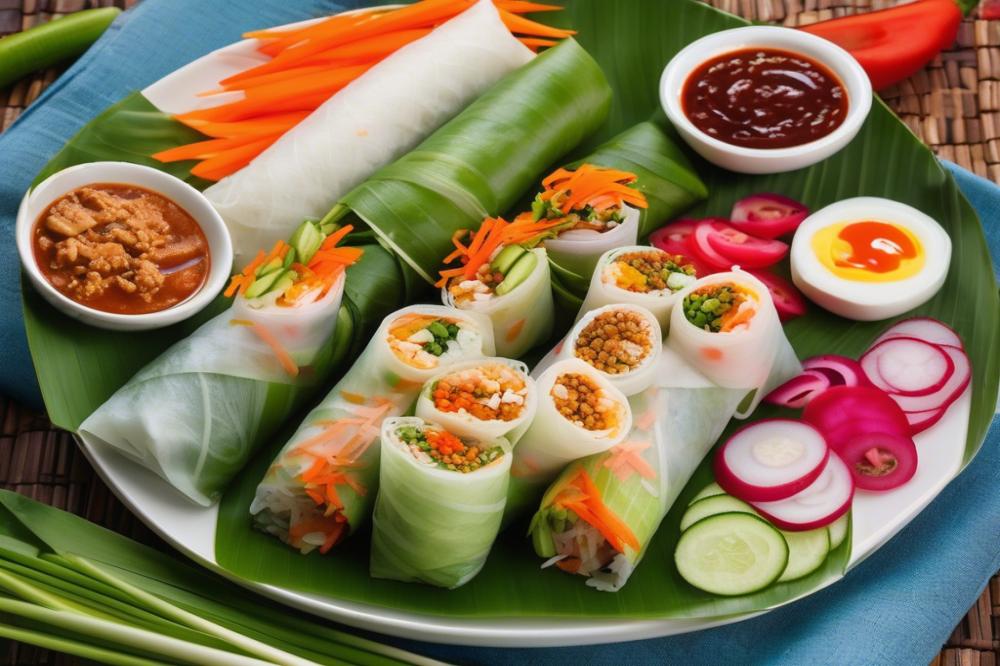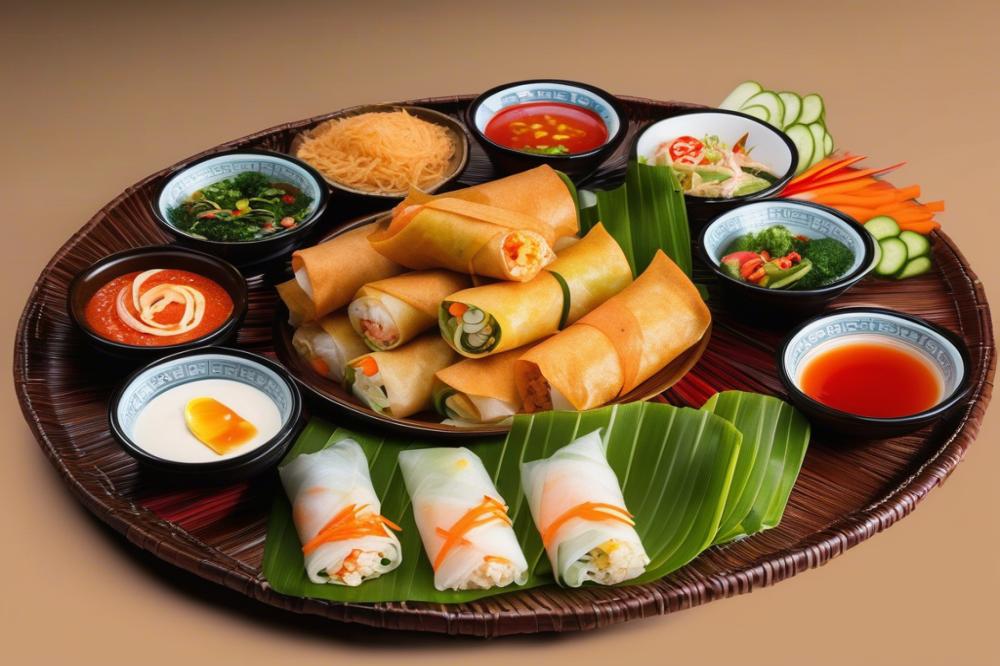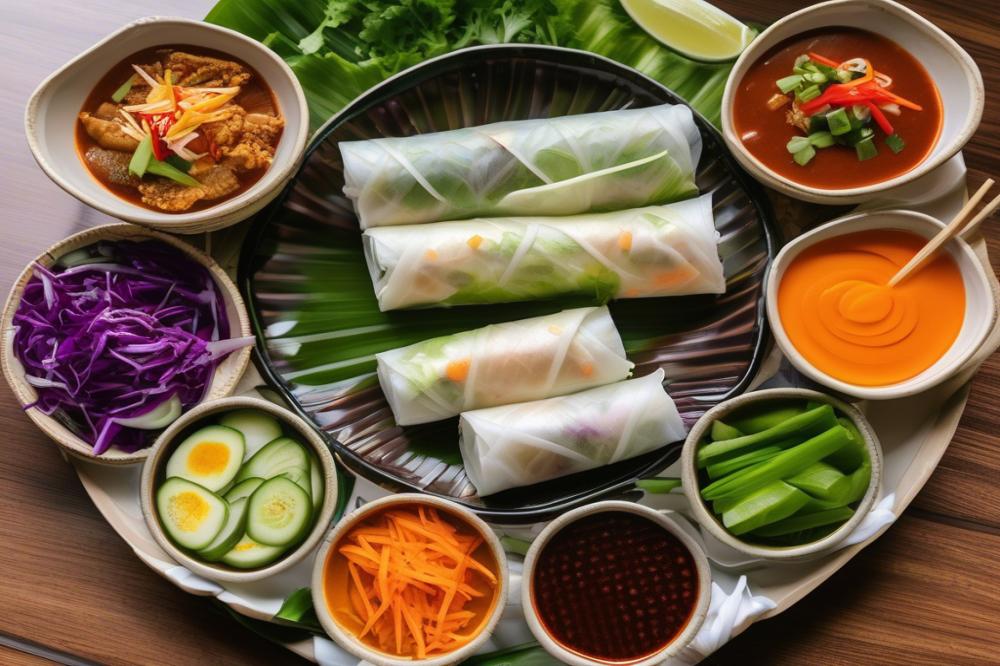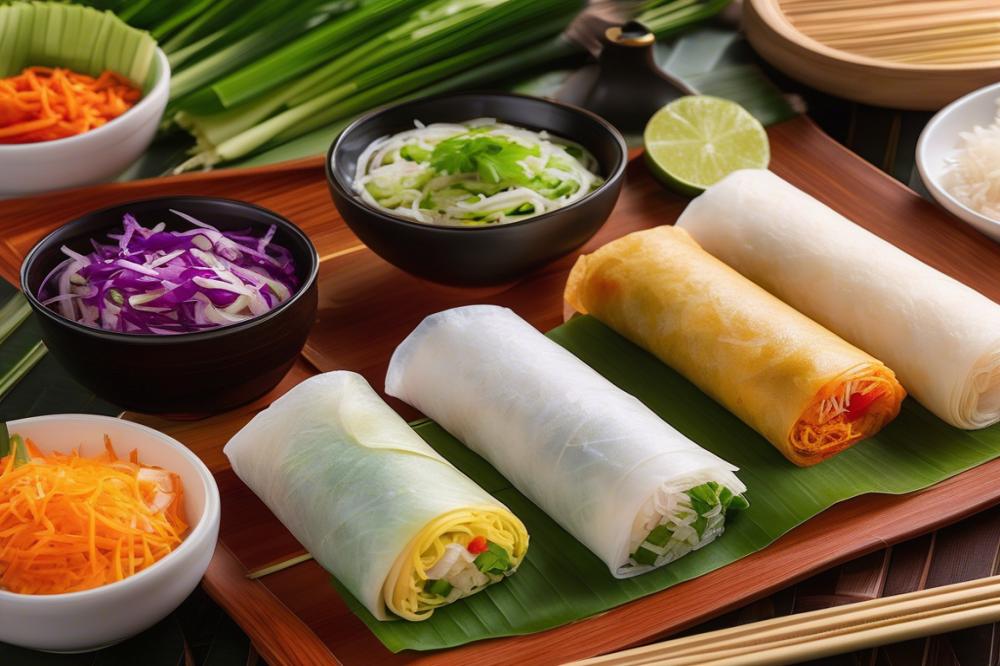Introduction
Popiah is a cherished dish in Malaysia, representing the essence of fresh spring rolls. This delightful food is often enjoyed as a snack or a meal. It holds a special place in Malaysian cuisine, especially within street food culture. Vendors across busy markets serve these rolled delights, showcasing their appeal to both locals and tourists alike.
The versatility of this dish is one of its best features. You can fill it with a variety of ingredients, depending on your taste preferences. From savory fillings made of vegetables and proteins to more simplistic vegetarian options, there is something for everyone. The use of rice paper adds a unique texture, making each bite a pleasant experience.
Dipping sauces accompany these spring rolls, elevating their flavor profiles. Whether you prefer sweet, spicy, or tangy, there’s a sauce to match your mood. Preparing your own Popiah recipe at home can be rewarding. Cooking instructions are straightforward, allowing anyone to enjoy this Malaysian favorite.
This dish blends flavors and textures in a way that few others do. Using fresh ingredients, one can create popiah that is not only delicious but also colorful. In a world filled with fast food, these Malaysian Spring Rolls offer a refreshing alternative. So, if you’re looking for a captivating dish to share, consider making these delightful rolls.
Understanding Popiah

Popiah, a type of fresh spring roll, is a beloved dish in Malaysian cuisine. This delightful snack consists of thin rice paper filled with a variety of ingredients. Its origins can be traced back to Fujian province in China, where the concept first took shape. Over the years, it has evolved into a vibrant part of the local food culture in Malaysia.
Regional Variations
In Malaysia, different regions feature their own interpretations of this dish. For instance, in Penang, the spring rolls often come packed with shrimp and bamboo shoots. On the other hand, the Kuala Lumpur style might emphasize a savory filling of fried tofu and bean sprouts. Northern states sometimes add peanuts or even a hint of sweetness with grated coconut. Each variant offers a distinct flavor profile, showcasing local ingredients and preferences.
Cultural Significance
This dish carries cultural importance and is often served on special occasions. Families prepare it during festivals like Chinese New Year and Hari Raya. Vendors sell popiah as a popular street food, making it a common sight during festive celebrations. Sharing these rolls with friends and family embodies hospitality and togetherness. Many cherish the tradition of wrapping their own spring rolls, which makes each occasion even more memorable.
The fresh spring rolls are not just a snack; they represent a shared experience within the community. When preparing a popiah recipe, the cooking instructions vary as much as the love that goes into each roll. A vegetarian option typically includes fresh vegetables and tofu, providing a wholesome choice for everyone. Served with a rich dipping sauce, these rolls create a burst of flavors that delight the palate.
Ingredients and Cooking Instructions

List of Ingredients
To start making Malaysian fresh spring rolls, gather these ingredients:
- Rice paper wrappers (10-12 pieces)
- Shredded vegetables, such as:
- 2 medium carrots, shredded
- 1 cup jicama, shredded
- 1 cucumber, julienned
- 1 cup bean sprouts
- Chopped herbs:
- 1/4 cup parsley
- 1/4 cup cilantro
- Savory filling options:
- 1 cup diced tofu (for a vegetarian option)
- 1 cup chopped mushrooms
- 1 cup cooked shrimp
- Dipping sauce mix:
- 3 tablespoons soy sauce
- 1 tablespoon chili paste
- 1 lime, juiced
Cooking Instructions
Now let’s get started with the cooking process:
Preparing Fillings: Begin by preparing all the fillings. First, wash and shred the vegetables. Chop the herbs finely. If using tofu or mushrooms, cook them lightly in a pan until golden. For shrimp, ensure they are fully cooked and chopped into small pieces.
Assembling the Popiah: Take a rice paper wrapper and dip it briefly in warm water until it’s soft. Lay it flat on a clean surface. Place a small amount of each vegetable, your chosen savory filling, and a sprinkle of herbs in the center. Fold the sides over the filling, then roll it up tightly, like a burrito. Repeat this process until all the ingredients have been used.
Serving and Presentation Tips: Arrange the fresh spring rolls neatly on a serving platter. Serve with bowls of the dipping sauce so that everyone can enjoy them as they like. Adding some lettuce leaves underneath can add a nice touch to the platter.
Nutritional Information
Here’s a breakdown of the nutritional value for each ingredient:
- Rice paper wrappers: Low in calories, primarily carbohydrates.
- Shredded carrots: Rich in vitamin A and fiber.
- Jicama: Contains vitamin C and is high in water content.
- Cucumber: Low in calories and hydrating.
- Bean sprouts: Source of protein and vitamins C and K.
- Parsley: High in vitamin K and antioxidants.
- Cilantro: Contains vitamin C and has anti-inflammatory properties.
- Tofu: Excellent source of plant-based protein and iron.
- Mushrooms: Low in calories, provide B vitamins and minerals.
- Shrimp: High in protein, low in fat.
- Soy sauce: Contains sodium, use in moderation.
- Chili paste: Can add spicy flavor, may have varying nutritional properties.
- Lime: High in vitamin C and adds refreshing acidity.
Variations of Popiah

Overview of Popular Variations
Fresh spring rolls can be incredibly diverse in flavors and textures. The fillings used in popiah can vary greatly. Cooked shrimp, shredded chicken, and stir-fried vegetables are just a few filling options. Some people enjoy adding a hint of spiciness with chili sauces. Others may prefer a sweeter taste, which can be achieved with a drizzle of sweet soy sauce. Certain recipes even include crunchy elements like crushed peanuts or fried shallots to enhance the texture.
Vegetarian Options and Adaptations for Dietary Preferences
Vegetarian options provide a fantastic alternative for those who avoid meat. Ingredients like tofu, mushrooms, and a mix of fresh vegetables make excellent fillings. Some recipes substitute soy sauce for mushroom-based sauces to keep flavors savory. This adaptation maintains the taste while accommodating dietary preferences. Those with gluten sensitivities may opt for rice paper wraps instead of traditional ones. These small changes can result in a delectable and inclusive dish for everyone.
Regional Differences in How Popiah is Made and Served
Each region in Malaysia brings its own twist to this beloved dish. In Penang, the fresh spring rolls are often filled with a combination of jicama, carrots, and shrimp, served with chili sauce on the side. In contrast, the southern regions might feature a more pronounced use of crunchy ingredients, such as fried tofu skin. Various locations also have differing expectations on how they are served. Some street food stalls offer popiah with a generous amount of sweet sauce, while upscale restaurants may plate it artistically with fine dining flair. The cooking instructions can even change, with families passing down their own cherished methods.
Celebrating these variations makes understanding Malaysian cuisine more exciting. Popiah exemplifies how food can be both comforting and adaptable. Its rich history shows how simple ingredients can lead to a multitude of flavors, making each bite a unique experience.
Serving and Enjoying Popiah
Traditional Ways to Consume Popiah
Popiah are best enjoyed fresh. Typically, they are eaten as a street food snack or light meal. Many people wrap them in rice paper, using a variety of savory fillings that may include vegetables, tofu, or chicken. In Malaysian cuisine, popiah are often served at gatherings or family dinners. A common method involves dipping them in a flavorful sauce before taking a bite.
Pairing Suggestions with Beverages and Side Dishes
When it comes to beverages, iced tea or fruit juices are popular choices. These drinks enhance the fresh taste of traditional Malaysian cuisine. For side dishes, consider serving crispy fried tofu or a simple salad. These items balance the meal and add texture. Lightly fried peanuts also make an excellent crunchy addition. Pairing these with fresh spring rolls elevates the whole experience.
Occasions to Serve Popiah
Many people enjoy making popiah during festivals or family gatherings. They are perfect for celebrations like Chinese New Year. Additionally, summer parties can also benefit from a popiah platter. Serving them at picnics adds a delightful twist. Whenever friends gather, these rolls create a casual atmosphere. They are also a great choice for vegetarian guests since many recipes focus on plant-based ingredients.
Bringing Tradition Home
Celebrated across Malaysia, this dish represents warmth and community. It often graces the tables during family gatherings and festive occasions, reminding everyone of their shared heritage. Through the act of making fresh spring rolls, families bond and create lasting memories. The process itself is joyful, filled with laughter and stories passed down through generations.
Trying out a popiah recipe at home can be a rewarding adventure. Preparing these rolls allows you to explore different ingredients and flavor combinations. Whether it’s crunchy vegetables or savory meats, each roll can reflect your personal tastes. Gathering friends or family to join in on the fun can make this experience even more enjoyable. Together, you can roll, wrap, and maybe even create your own secret sauce!
Ultimately, creating and sharing this delightful dish can bring people closer. As you savor the flavors of your homemade spring rolls, you also celebrate the cultural significance embedded in each bite. Closing the meal with laughter and shared stories creates warmth that lingers long after the last roll is gone. Embrace the tradition and enjoy every moment spent in the kitchen and at the table with loved ones.



